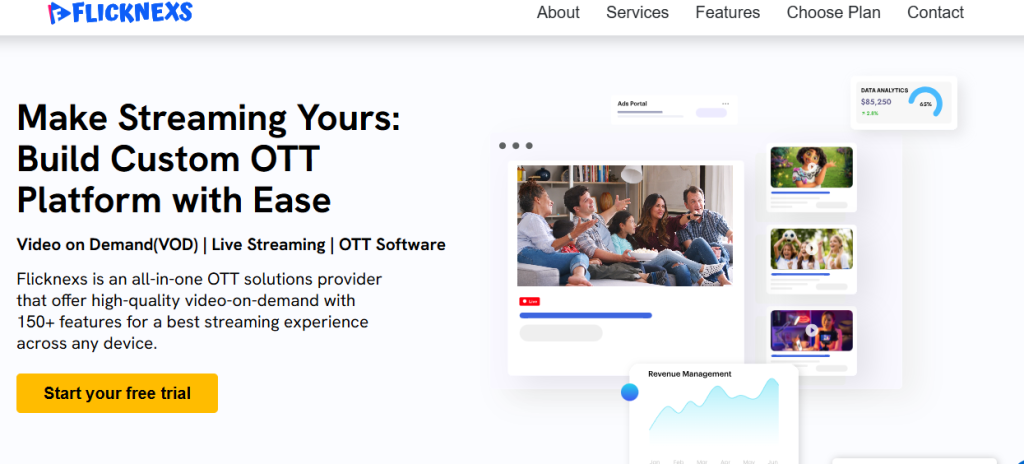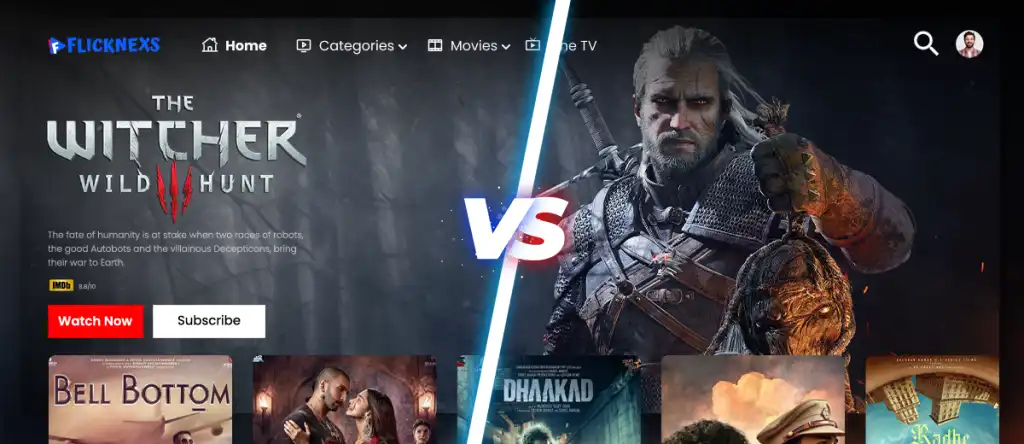VOD vs OTT represents the two major ways audiences consume video content today.
VOD (Video On Demand):
Access pre-recorded content anytime, anywhere on smartphones, tablets, or smart TVs.
OTT (Over-The-Top):
Stream content directly over the internet, including both on-demand and live broadcasts, bypassing traditional cable.
2025 Market Trends:
- OTT Market: $343.8B
- VOD Market: $304.85B by 2030
In 2025, the global Over-The-Top (OTT) video market is projected to reach $343.8 billion in revenue, surpassing the Video On Demand (VOD) market, which is expected to hit $304.85 billion by 2030. OTT delivers video content directly over the internet, including live and on-demand streams, while VOD allows viewers to access pre-recorded videos at their convenience. Understanding the differences between these two platforms is essential for content creators, marketers, and viewers navigating the rapidly evolving digital entertainment landscape.
What is VOD?
Video On Demand allows users to access and watch video content at their convenience.
It enables viewers to select and stream movies, TV shows, or other videos directly to their devices, such as smartphones, tablets, or smart TVs, over the internet.
VOD eliminates the need for traditional broadcast schedules, providing users with the freedom to watch content anytime, anywhere.
Not including that, on demand contents can be streamed over the internet, cables as well. With VOD, viewers have control over what they watch, pausing, rewinding, or fast-forwarding as desired.
Popular VOD platforms include Netflix, Amazon Prime Video, Hulu, and Disney+, offering a wide range of content for on-demand viewing pleasure.
How Does VOD Work?
Content Delivery: VOD works by storing video content on servers or cloud-based platforms.
User Request: When a user wants to watch a specific video, they send a request to the VOD service provider through a connected device, such as a smart TV, computer, or mobile device.
Video Streaming: The VOD server retrieves the requested video from its storage and initiates the streaming process.
Adaptive Streaming: VOD systems often employ adaptive streaming techniques to optimise video quality based on the user’s internet connection.
On-Demand Playback: It enables users to have full control over their viewing experience.
Digital Rights Management: The services employ DRM mechanisms to protect the copyrighted content from unauthorised distribution. DRM ensures that only authenticated users with proper rights can access and view the video content.
What is OTT Streaming?
OTT streaming refers to the delivery of video content over the internet directly to viewers, bypassing traditional broadcast or cable television platforms.
It allows users to access and stream a wide range of on-demand movies, TV shows, and other media content anytime, anywhere, using various internet-connected devices such as smartphones, tablets, smart TVs, and streaming devices.
OTT streaming services, such as Netflix, Amazon Prime Video, and Disney+, offer subscription-based models that provide users with a vast library of content to choose from, often without the need for a cable or satellite TV subscription.
It has revolutionized the way we consume entertainment by providing flexibility, convenience, and personalized viewing experiences.
How Does OTT Work?
Content Providers: OTT platforms are typically operated by content providers who acquire or produce various forms of digital content.
Streaming Technology: It relies on streaming technology to deliver content directly to viewers devices over the internet.
Internet Connectivity: OTT requires a stable internet connection for users to stream content seamlessly.
Subscription or Ad-supported Models: The platforms generally operate on either a subscription-based or ad-supported model.
Subscription-based services require users to pay a monthly or annual fee to access content, while ad-supported platforms offer content for free but display advertisements during playback.
On-Demand Access: OTT enables on-demand access to content, allowing viewers to choose what they want to watch and when they want to watch it.
Personalization and Recommendation: OTT platforms often employ algorithms and data analytics to personalise the content recommendations for users.
By analysing users’ viewing habits, preferences, and ratings, these platforms can suggest relevant content based on individual tastes, enhancing the user experience.
Short video of VOD vs OTT
Advantages Of VOD
- Access content anytime, anywhere with Video on Demand.
- Wide selection of movies and shows to choose from.
- Pause, rewind, and fast-forward through your favourite programs.
- Pay for what you watch without additional fees.
- Tailor your viewing experience to your preferences.
- Enjoy immediate access to desired content.
- Available on multiple devices and platforms.
Advantages Of OTT
- Vast selection of movies, TV shows, and documentaries.
- Tailored recommendations based on individual viewing preferences.
- Choose what to watch and when to watch it.
- Exclusive shows and movies not available elsewhere.
- Access content anytime, anywhere with internet connection.
- Stream on smartphones, tablets, smart TVs, and more.
- Download content to watch offline without internet connection.
- Available worldwide, breaking geographical boundaries.
What is the difference between VOD and OTT?
Video On Demand (VOD) lets viewers watch pre-recorded content whenever they want, giving full control over playback. Over-The-Top (OTT) delivers video content via the internet directly to devices, including live streaming, bypassing traditional cable or satellite services. VOD focuses on content access, while OTT covers delivery methods and device reach.
Difference Between VOD vs OTT
| Feature | VOD | OTT |
|---|---|---|
| Content Delivery | Pre-recorded videos on-demand | Live and on-demand streaming over the internet |
| Device Compatibility | Smartphones, tablets, smart TVs | Smartphones, tablets, smart TVs, desktops, streaming devices |
| Subscription Model | SVOD or pay-per-view (TVOD) | SVOD, AVOD, or hybrid models |
| Content Control | Full playback control | Limited for live, full for on-demand |
| Use Case | Best for binge-watching or scheduled viewing | Ideal for live events and global streaming |
How Flicknexs Helps in VOD vs OTT

Flicknexs leverages both Video on Demand and Over the Top platforms to offer diverse content delivery. VOD allows users to access and stream content on-demand, providing flexibility in viewing choices.
On the other hand, OTT extends the reach beyond traditional broadcast, delivering content over the internet without the need for cable or satellite subscriptions.
Flicknexs seamlessly integrates these technologies, ensuring a user-friendly experience with a vast array of on-demand content while embracing the convenience and accessibility of OTT distribution.
This dual approach enhances viewer engagement and positions Flicknexs at the forefront of the digital streaming landscape.
Conclusion
VOD vs OTT are two concepts that are frequently used in the context of video content and streaming services. Even while they could at first look seem similar, they have clear differences.
VOD vs OTT both involve streaming videos over the internet, but their main focuses differ. OTT encompasses a wide array of services, including live streaming and various OTT platforms.
On the other hand, VOD concentrates specifically on providing on-demand access to recorded content. These terms are not mutually exclusive, as VOD can be incorporated within an OTT streaming service.
Understanding the difference between VOD vs OTT is crucial when navigating the ever-evolving video industry and selecting the most suitable content provider to your preferences.



Leave a Reply